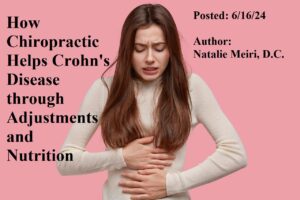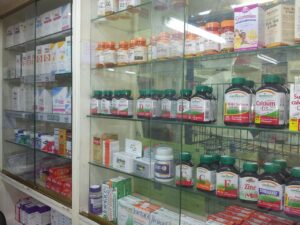
Crohn’s disease is a chronic, inflammatory bowel disease that causes inflammation in the digestive tract. In Crohn’s disease, inflammation can occur anywhere in the GI tract from the mouth to the anus. Additionally, Crohn’s disease will have patches of inflamed areas mixed closely together with healthy tissue. Fistulas are a common complication of Crohn’s disease. These are “small tunnels” that form between two organs due to inflammation and sores. The cause is attributed to autoimmune disease.
Symptoms are gut-related (crampy, abdominal pain, diarrhea, rectal bleeding, loss of appetite, and weight loss), including pain and urgency, joint pain, anemia, and issues with skin, bone, eye, liver, and kidney health. In other words, it may be accompanied by systemic (whole body) symptoms. The goal in treating Crohn’s disease is to focus on symptom remission, rather than a cure.
Fortunately, chiropractic spinal adjustments along with proper vitamins and supplements, can help you keep the symptoms under control. Read on to find out How Chiropractic Helps Crohn’s Disease through Adjustments and Nutrition.
More on Crohn’s Disease
Crohn’s disease affects men and women equally and tends to run in families. And if the crohn’s disease continues for many years, your intestinal function deteriorates. Left untreated, it can become serious and may increase the risk of cancer and necessary surgery. Most are diagnosed when they are between 15 and 35 years old, though anyone can be diagnosed with Crohn’s at any age.
Multiple factors may be involved such as microorganisms including fungi, bacteria, and viruses. However, the definitive cause is not known. Furthermore, if you have Crohn’s disease, you may also have nutritional deficiencies. Lastly, Crohn’s disease can lead to Enteropathic Arthritis.
Crohn’s Disease Can Lead to Enteropathic Arthritis
How Crohn’s disease leads to enteropathic arthritis is not fully understood. But observations have been made where joint inflammation occurs in genetically predisposed persons with bacterial gut infections. Accordingly, this provided important evidence for a possible relationship between inflammation of the gut mucosa (inner lining of gut) and arthritis. So current theories propose that genetically predisposed persons have an aberrant migration (movement) of intestinal lymphocytes (immune cells) and macrophages (white blood cells) from inflamed gut mucosa to joints. Finally, intestinal bypass surgery may also be related to acquiring enteropathic arthritis.
What is Enteropathic Arthritis?
So enteropathic arthritis is a disease that has a gastrointestinal origin (e.g. Crohn’s disease) and results in arthritis. It’s an inflammatory arthritis with symptoms of lower back pain and stiffness. Additionally, Crohn’s disease and intestinal infections (e.g. Salmonella, Shigella, Whipple’s disease) can produce arthritic abnormalities. Never the less, the cause of enteropathic arthritis is not fully understood either.
Enteropathic Arthritis occurs at variable ages and equally in both genders. About one in five people with enteropathic arthritis will have inflammatory arthritis in one or more peripheral (limb) joints / extremities (arm or leg). And lower limbs are more commonly affected.
The severity of the peripheral (limb) arthritis normally coincides with the severity of the inflammatory bowel disease. Therefore, when diarrhea and abdominal pain are flaring, the peripheral arthritis tends to flare, as well.

Chiropractic in West Palm Beach, FL
Firstly, management includes chiropractic manipulation treatment to keep the spine and extremity (arms and legs) joints flexible. Secondly, Chiropractic manipulation should be as gentle as possible considering the inflammatory nature of these diseases. Thirdly, stretching and postural exercises are very helpful. Fourthly, adjustments to your spine help improve the relationship between the spine and nervous system, which affects the function of all the organs and systems in your body. Fifthly, lifestyle changes/nutritional recommendations are necessary.
Supplementation Recommendations for Crohn’s Disease
Duodenal Glandular- helps heal gastrointestinal ulcers.
L-Glutamine– helps the surfaces of the intestines to heal
Vitamin B complex– needed for breaking down fats, protein and carbohydrates in digestion and helps to prevent anemia
Extra Vitamin B6, B12 and Folic Acid– frequently depleted in patients with Crohn’s disease
N-Acetylglucosamine (There are several forms of glucosamine, including glucosamine sulfate, glucosamine hydrochloride and N-acetyl glucosamine.)- it helps form the barrier tissue that protects the intestinal lining from your own digestive enzymes and other damaging substances passing through the intestines. N-acetylglucosamine prevents leaky gut syndrome.
Omega -3 essential fatty acids– Important in repairing the digestive lining. Some studies show it may aid in Crohn’s disease remission.
Pancreatin and Bromelain– Enzymes that help break down protein and digestion.
Taurine (essential amino acid)– Important as an antioxidant and immune regulator
Vitamin C with bioflavonoids– for immune function and healing intestinal lining.
Vitamin K- important for colon health. Deficiency is common in Crohn’s due to malabsorption and diarhea.
Zinc- required for immune system. Zinc Gluconate lozenges may be utilized.
Free-form Amino Acid Complex (free form are predigested/already separated– for tissue healing, protein is needed
Garlic- Fights free radicals involved in Crohn’s disease
L-Acidophilus and L. bifidus– helps in overflow of undigested food particles and reduces inflammation
Plant based protein– between meals to balance out sugar levels and for necessary protein
Calcium and Magnesium– prevention against cancer.
Iron- to prevent anemia
Multivitamin and mineral complex with copper, manganese, selenium plus extra potassium- Malabsorption occurs with Crohn’s disease. Copper, selenium and manganese are often deficient.
Quercetin– slows histamine (Histamine is a signaling chemical your immune system releases to send messages between different cells. Histamine has several functions, but it’s mainly known for its role in causing allergic symptoms release). Helps control food allergy and needed for enzyme function.
Shark Cartilage– Keeps cancer cells from spreading
Vitamin A and E– Antioxidants help in controlling infections in the intestines.
Vitamin D3– Prevention in metabolic bone disease due to malabosorption.
Aloe Vera – helps heal colon and aids in pain relief
Burdock root, echinacea, fenugreek, goldenseal, licourice, marshmallow root, red clover, rosehips, pau d’arco, peppermint, milk thistle, red clover, yerba mate, slippery elm – cleanses the blood. Milk thistle additionally enhances liver function. Also reduces infection and inflammation.
Diet/Lifestyle for Crohn’s Disease
First, Eat a diet to help replace lost nutrition. Eating a diet consisting of non-acidic fresh or cooked vegetables such as broccoli, brussel sprouts, cabbage, carrots, celery, garlic kale spinach and turnips are excellent choices. It’s best to steam, broil, boil or bake for easy digestion.
Second, proper hydration is important (plenty of herbal teas and fresh juices).
Third, when an exacerbation occurs, organic baby foods, steamed vegetables and well cooked brown rice, millet and oatmeal is best.
Fourth, all dairy foods should be eliminated. Many people are allergic to the carrageenan, a compound extracted from red sea weed. This compound is used to stabilize milk proteins. It is known to cause crohn’s type diseases in mice in research.
Fifth, alcohol, caffeine, carbonated beverages, chocolate, corn, nuts, eggs and foods with artificial additives or preservatives, fried foods, tobacco, white flour should be eaten in moderation.
Sixth, try to avoid wheat, rye and barley as well. Sugar and refined carbohydrates have been linked to Crohn’s disease. Sugar must be eliminated as much as possible.
In summary, adhering to an allergen free diet, replacing lost nutrition/hydration and using herbs for healing is key. And Staying stress free and getting enough sleep is crucial.

Research on Crohn’s Disease and Chiropractic Care
An interesting 2002 article in the Journal of Vertebral Subluxation Research examined the possible connection between spinal subluxations, and symptom remission and alleviation in patients with both Crohn’s disease and allergies. From a group of 51 patients, 17 were assigned to receive spinal adjustments in the thoracic (midback) and lumber (low back) regions, while the other 34 did not get adjusted.
Of those patients who received adjustments, 12 had long-term, stable symptom remission periods. Moreover, nine of those 12 patients reported symptom alleviation. The researchers concluded that adjustments to the region of the eighth to 10th thoracic vertebrae, which relate to the adrenal glands, seemed to be the most effective in treating symptoms of Crohn’s disease.
How Chiropractic Helps Crohn’s Disease through Adjustments and Nutrition
Indeed, long-term use of pain medication/drugs can cause gastric and renal (kidney) consequences. In conclusion, chiropractic care along with the use of a correct diet and supplement recommendations are helpful for management of ulcerative colitis.
At Meiri Chiropractic we spend the time necessary to examine, diagnose and treat every neuromusculoskeletal condition and various ailments you have. Chiropractic is a holistic and natural way to not only treat existing conditions, but to keep your body in its best working condition. We have been offering effective chiropractic care in Palm Beach county since 2006. Many of our patient reviews note our excellence. Call us today at 561-253-8984 to make an appointment or to find out more about How Chiropractic Helps Crohn’s Disease through Adjustments and Nutrition.
*For all the above, please check with your primary care doctor before implementation of supplement/diet recommendations.
References:
- References: Prescription for Nutritional Healing (3rd edition), Phyllis A. Balch, CNC
- References: Jame Gerber, Hand book of Preventative and Therapeutic Nutrition, 1993
- Takeda
Y, Arai S, Touichi H. Longterm remission and alleviation of symptoms in allergy and Crohn’s disease
patients following spinal adjustment for reduction of vertebral sublaxations.
Journal of Vertebral Subluxation Research. 2002;4(4):131-141.